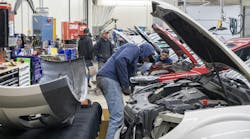Secrets to New Customer Acquisition
Collision repair is an on-demand service. That’s the very first thing every shop needs to understand, says Michelle Nelson, president of Back 2 Basics Marketing.
“It’s pretty simple: When you’re reaching out, the customer likely doesn’t need you at that time,” Nelson says.
“When they do need you,” suggests Steve Schoolcraft, president of Phoenix Solutions Group, “they are simply looking to get a product they already own back to the state they previously had it. There isn’t a satisfaction element to it the way there would be for buying a car, or a watch, or anything.”
Because of that, marketing for the collision repair industry is a “completely different animal” and requires a completely different set of marketing tactics to effectively reach customers than that of an impulse-buy industry, Schoolcraft says.
And this difficult situation is exactly why so many shops fail in their marketing efforts.
Luckily, both Nelson and Schoolcraft have dedicated their careers to finding marketing that works in this industry, as have Bob Coleman of RC Marketing LLC and Eric Seidel, CEO of Web-EST.
Each of these four marketing gurus shared their top tips for new customer acquisition—and how any shop, regardless of size, can implement them immediately.
The Referral: A Five-Year Plan
Steve Schoolcraft, president, Phoenix Solutions group
For decades the simplest yet most effective way to gain new customers has always been referrals from friends and families.
Don’t underestimate referrals, Schoolcraft says. And don’t overthink the process either.
Schoolcraft has years worth of research—plenty coming in the last year—that shows customers still look to the people closest to them for purchasing advice. Yet, he also has analytics that show collision shops are missing the boat on these opportunities.
His staff conducted phone interviews with 4,000 customers of various repair shops at the beginning of 2013. He asked three simple questions: 1) Was the customer still satisfied with the repair? 2) Did they have friends or family that would also need these services in the next year? And, 3) Would they refer the shop they used to those people?
The answers were telling: Schoolcraft said 87.6 percent were still satisfied, and of those people, nearly 100 percent knew of other people who could also use those services. Yet, when it came to the third question, an overwhelming amount answered no, they would not refer.
“The answers varied for why,” he says, “but most of that came down to them describing their experience as just ‘average.’
“People don’t refer on ‘average’ reviews. You’re not going to tell your buddy, ‘Oh, you have to try this restaurant; it’s really average.’ Customers are looking for the next level. They’re looking to be wowed. And that’s how you get referrals.”
And, Schoolcraft says, it’s a lot simpler than you think; it’s about experience.
That starts with your shop’s customer service—things like a proper greeting, proper phone etiquette, sound updating procedures, etc.
Technically, that’s part of your marketing, but Schoolcraft says the real legwork comes when the repair experience is complete—and it should last for at least another five years with each customer.
Schoolcraft stresses with each of his clients that to truly gain ground on referrals, a shop needs to stay in front of its customers for five years following the repair.
The first step is a handwritten thank-you note and/or a direct phone call just days after vehicle delivery, followed shortly by a letter containing the shop’s warranty. Then, Schoolcraft implores his clients to send brief nonpromotional follow-up letters to each customer at the three-month, six-month, one-year, 18-month, two-year, three-year, four-year and five-year anniversary of the repair.
“You’re not selling them anything, you’re not promoting anything,” he says. “All you’re doing is sending a letter with a handwritten signature, asking them if they are still satisfied with the work you did and reminding them that the repairs are under warranty if they have any issues.”
A customer isn’t going to expect this from a shop, Schoolcraft says, and this will help you stand out in their mind. It shows you care about the quality of your work, about the customer, and that’s what is going to lead to them referring your shop.
“From all the research we’ve done, everything we’ve looked into, I can say that this is the absolute No. 1 way to get new customers to come to your shop,” he says. “And it’s not hard, but you have to have a process in place, you have to stay on top of it. Shops aren’t doing this, and they’re completely missing out.”
Agent Marketing: Feet on the Ground
Bob Coleman, consultant/founder, RC Marketing LLC
One of Coleman’s largest areas of focus, he says, is on repeat outside sales visits to insurance agents and businesses with potential fleet accounts.
These are referral sources,” he says. “[They are] often the first place customers will get a recommendation when they get into an accident.
“It can take a long time to develop a relationship with these people to where it really works effectively, but it’s something you can start quickly.”
By definition, outside sales refers to going out into the field to conduct visits to potential customers. Although, Coleman says, don’t confuse this with making a sales pitch.
“This is about relationship building—friendly conversations and interactions to help people get to know you and your brand,” he says.
It’s something that’s talked about often in the industry, but rarely, Coleman says, do clients ever have a firm grasp of how to implement the strategy.
Coleman says the process is relatively simple:
Step 1: Identify marketing targets. Clearly outline the perimeter of your shop’s market reach. Then, identify all possible people and businesses to market to. Make a list of all insurance agents (corporate or independent) and track down all businesses with potential fleet accounts. Do some research and rank how much each marketing target impacts your customer base.
Step 2: Develop a schedule. Based on your ranking, you can schedule how often to visit certain businesses, and when to do it. Coleman suggests visiting each once per month; some may require extra visits, some not as many.
Step 3: Create branded handouts. Pens, post-it notes, coffee mugs—the point is to give things that will remain on a person’s desk or will be easily remembered. Each item should be branded for your shop.
Step 4: Build a comfortable, friendly presentation. These should be relaxed, casual visits, Coleman says. “You’re popping in to say, ‘Hi,’” he says, “not making a sales pitch.” Dress business casual and try to keep talk light or about any new happenings or events your business is tied to.
Step 5: Stay with it. The most important part of this being successful, Coleman says, is doing it regularly over a long period of time to demonstrate to these businesses your commitment to building that relationship. “Don’t give up. The results will come.”
The Marketing Caveat
All marketing strategies do not work for all shops. Reread that sentence over and over before moving on, Schoolcraft suggests.
Every shop has a unique set of factors that it must assess before deploying any marketing tactic. Schoolcraft breaks down the very basic elements:
1. Your MarketPlace. Understand the size and opportunity of your market and its demographics.
2. Your Customers’ Buying Behavior. Where do your customers get their buying information? Where do they look? How often? What influences their decisions the most?
3. Your Shop’s Work Mix. Where does your work come from? For instance, a direct-repair-focused shop has much different marketing priorities than a shop with few or no DRP agreements.
Accessibility: Make Your Shop Easy to Find—Online
Michelle Nelson, President, Back 2 Basics Marketing
If Nelson were to get into a car accident today, she says she knows exactly whom she would call to work on her vehicle. She also realizes that puts her in the minority of American consumers.
“Let’s face it, it’s not something most consumers are ever thinking about,” she says. “Even your previous customers, it’s likely been years since their last accident, and there’s plenty of research that shows that if you didn’t do a good job staying in touch with them, they won’t even remember your shop’s name.”
It’s another reason Schoolcraft’s advice rings true—and it’s also why you need your shop to be easily searchable online, and to provide a good brand presence when it is found.
“Say you get a referral from a friend or relative,” Nelson suggests, “do you automatically take their word on it? You might trust their opinion, but don’t you still usually look them up and research a bit, too?
“Your website, your reviews, your overall Web presence has to back up that referral.”
The first step, Nelson says, is having a professional website that includes all the proper information, and gives credence to the image your shop and branding wants to portray. It needs proper calls-to-action (e.g., clear phone number, online estimate or appointment-scheduling portal). It needs the proper keywords and tags to improve search engine optimization (SEO). And it cannot have grammar or spelling errors. Attention to detail is the key, she says.
It also needs a mobile version that customers can easily access anytime, from anywhere.
“And then you have the new-age referral process—online reviews,” Nelson says. “These are becoming more and more important to customers’ purchasing decisions, and it affects SEO.”
“You need potential customers to understand the value you can provide,” she adds. “And you need to make it easy for them to discover that.”
What Works—and What Doesn’t
Schoolcraft and his team at Phoenix Solutions Group send 40–50,000 surveys to customers of his clients each month. Because of that, his company has an abundance of analytics that demonstrate what works and what doesn’t when looking to acquire new customers.
Here are Schoolcraft’s most and least effective marketing tactics, based on what his research says collision repair customers pay most attention to in making their choice of a repair facility:
- Referrals
- In-person marketing directly to insurance agents
- Online reviews
- Social Media
- Billboards and TV
Paid Search: How to Turn a Click into a Sale
Eric Seidel, CEO, Web-Est Inc.
Seidel has seen it with shops over and over: The phone rings, and that customer is instantly a priority. But the same shop gets a sales lead online, and it sits there … and sits there … until that customer has moved on.
“This is how shops fail with paid search marketing,” he says. “They treat those two sales leads differently, they lose that online customer, and then they say paid search doesn’t work.
“They’re both sales leads, and for that marketing tactic to work, they need to be treated the same.”
Paid search, or pay-per-click (PPC) advertising, allows businesses to position themselves on a search engine’s results page based on the level of campaign they are running. It’s a way to boost SEO, and it’s a way to put yourself in front of potential new customers already searching for your services.
The campaign can be set up so that the customer contacts the shop directly by phone or electronically, which is where Seidel noted the snag in the progress.
“Response time is going to be critical, regardless,” he says. “It should be measured in minutes, not hours, and certainly not days.”
The first step, Seidel says, is to create a calendar of when the PPC campaigns will take place. This allows the shop to be organized with the message and effectiveness of each ad—and also prepare the front-office team for incoming inquiries. The second step is to have a process in place for who is handling those inquiries. If it’s a designated phone line or an online portal, there should be someone monitoring that, just as you monitor your shop’s standard phone line.
But, overall, Seidel advises to make sure to focus on the consistency of handling the campaign.
“It’s like anything else, the more you put into it, the better the results are going to be,” he says. “SEO is like monopoly—the more you own, the better you do.”
The ‘Big’ Picture
The MSO viewpoint
Steve Rigsby is the marketing manager for the 11 Colorado CASRSTAR locations. He says there are plenty of marketing advantages that come with being part of a larger organization—a larger budget, more name-recognition opportunities, increased insurer relationships, etc.
In a nutshell, he says his strategy with CARSTAR has been about market saturation of the brand, something that shops of any size can try to accomplish on their respective scales. Here are his top two tactics for gaining new customers:
Jumping on the Bandwagon. CARSTAR bought the rights to the interview backdrop used this season with the NFL’s Denver Broncos. In a football-obsessed region, he says, this went a long way to increasing brand awareness. Although most shops can’t afford such a campaign, Rigsby says to look for events or initiatives in your community to attach your brand to—things that will give potential customers a good association with your brand.
Providing Insurer Continuing Education Classes. This is something all shops can do, and while steering laws mean you have to present these classes in the proper way, Rigsby says it’s another step for brand awareness from the other side of the repair process.




